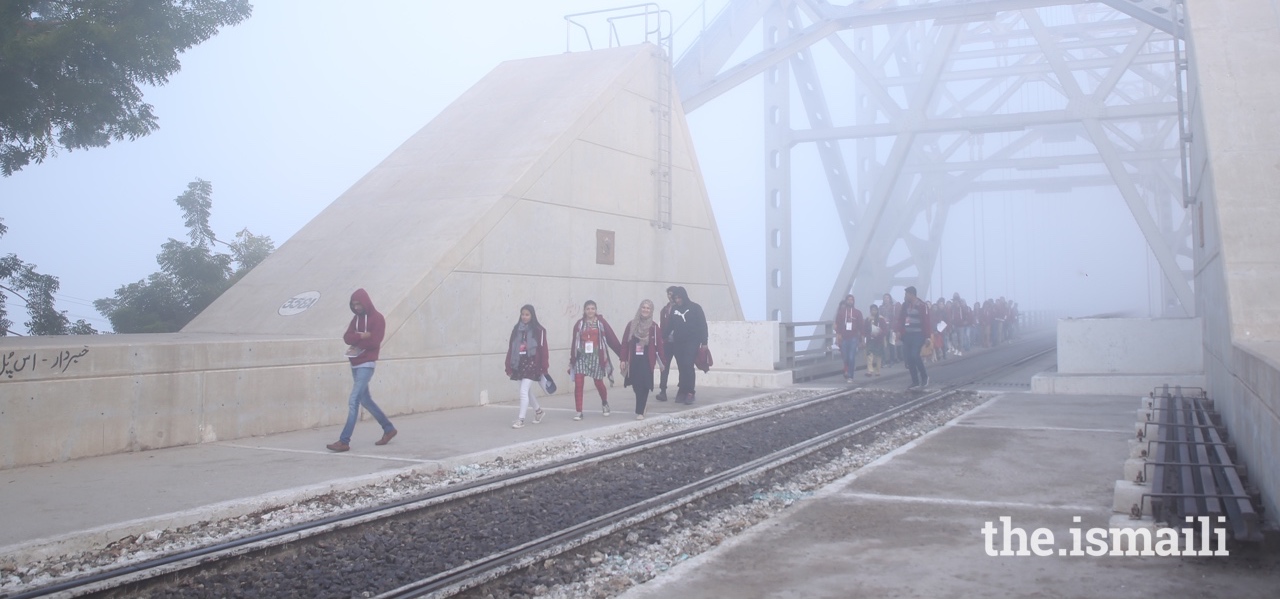hdt_crop_1.jpg

Starting in Sukkur in the southeast province of Sindh, 30 participants between the ages of 16 and 20 met with the local Jamat. They learned from elders about the tangible and intangible cultural heritage of the city and how the lifestyle and living traditions of the Jamat have evolved over time. The conversations demonstrated the greater need for young people to connect with their history and culture, and particularly their elders — the sources of many wise stories and folk traditions. This was a lesson befitting HDT, which aims to help participants gain knowledge, understanding, and appreciation of the rich cultural heritage of Pakistan and the Jamat in the country.
The following morning, HDT participants visited Sukkur Bridge, also known as Lansdowne Bridge, a 19th-century crossing that spans the Indus River between the cities of Sukkur and Rohri, in the province of Sindh. They also visited the exterior wall of the Tomb of Seven Sisters, a site located just across the bridge on the left bank of the Indus River. The group then embarked upon an unforgettable journey to Kot Diji Fort, also known as Fort Ahmadabad, the 18th century Talpur-era fort located in Khairpur District in Sindh, to explore the expanse of the structure and ingenious engineering skills of people of the era. Mohenjo-Daro, an archaeological site and one of the world's earliest major cities, was the next destination. It was built around 2500 BCE and was one of the largest settlements of the ancient Indus Valley Civilization. It is astounding to know that only 10% of the site has been excavated, whereas 90% of the site remains a mystery. The day concluded with a musical performance in Sehwan, the city of famous Sufi saint and poet Lal Shehbaz Qalandar.
hdt_crop_2.jpg

The tour provided an opportunity to explore the history, culture, living traditions, and landscape of the regions.
“HDT is a prolific learning excursion to heritage sites, including places with splendid traditional, religious, cultural, educational, and historical themes. During this time, I did not read history, I felt it,” said participant Javeria Khan from Upper Chitral in northern Pakistan. “It was an exhilarating experience that imparted an empathetic eye and attentive ears. The tour has impressed upon me our nation’s heartfelt culture and its lively impact. Now, I can work diligently for the preservation of my country's heritage while simultaneously working with my peers.”
The third day started with a visit to the Shrine of Lal Shehbaz Qalandar in Sehwan, after which participants moved on to Manchar Lake, the largest freshwater lake in Pakistan, to gain an awareness of the repercussions of environmental degradation and its impact on the lifestyle of inhabitants. Locals shared their stories, and explained how polluted water has unfortunately destroyed marine life and livelihood.
After meeting locals near Manchar Lake and before travelling to Bhit Shah, participants visited the historical Rani Kot Fort, also known as the great wall of Sindh. In Bhit Shah, the group visited the 18th-century Shrine of the Sufi saint and poet Shah Abdul Latif Bhittai, where they experienced dhammal, a meditative dancing ceremony, followed by a block printing workshop. Here, they spent time with artisans who not only produce hand block printed ajrak, but also extract colours from organic products such as turmeric. Participants also visited the Gurdwara of Bhit Shah before the day ended with traditional food and music.
hdt_crop_3.jpg

The following day, participants travelled to visit a joint Muslim and Hindu shrine located in the village of Odero Lal, near the city of Tando Adam Khan. The site is jointly used for worship by members of both faiths. After this, the group visited NITA crafts in the village of Nasarpur to observe how tiles are made. The owner of NITA explained how they aim to revive the tradition of tile making and help in the restoration of Islamic art and architecture. The group then travelled to Hyderabad and celebrated a cultural evening with the Jamat there.
On the morning of day five, participants visited Talpur Tombs, a complex of tombs of the ruling Talpur Mirs of Sindh who reigned from 1784 to 1843. The deteriorating exterior of the tombs highlighted the importance of restoration and conservation. Participants then had the privilege to visit the Aga Khan Palace in the historical town of Jhirk in Thatta. The palace was built by Aga Khan I, and still exists today, remaining in pristine condition.
Participants also visited the Imam Bargah near the palace and Makli Necropolis, one of the largest funereal sites in the world, spread over an area of 10 kilometres. Next, the tour group visited the Shah Jahan Mosque in Thatta, a 17th-century building constructed during the reign of Mughal emperor Shah Jahan. Everyone was amazed at the sophistication of the architectural style of the mosque and drew patterns of the blue tiles in their travelogues. After spending time in the mosque, the group departed for the southern port-city of Karachi.
hdt_crop_4.jpg

Overall, the HDT excursion offered a unique opportunity for participants to observe the diversity of the country and the Jamat, and to reflect and understand the importance of cultural heritage in shaping identity.
“HDT 2019 was an inspiring experience,” said Irshad Qabool from Hunza in the north of Pakistan. “Through this tour, we explored cultures which were unknown to us. Similarly, this tour made us realise the importance of heritage and the history of our civilisation in society, as it binds people through shared beliefs and values.”
The sixth day began with a tour at the Aga Khan University’s Centre for Innovation in Medical Education and observed the use of artificial intelligence in medical research. A guided tour of the facility inspired some participants to apply for the MBBS programme at AKU as well as to initiate collaborations with other medical universities in Sindh. The group then visited Khadijabad Jamatkhana for lunch and took part in a reflection session of the tour.
On the final day of the tour, the group spent half the day visiting the National Academy of Performing Arts, the Artists Commune Colony, and Aga Khan Gymhana, where they ended the tour with lunch. Participants then travelled back to their homes with a broader knowledge about historical traditions and the heritage of their ancestors.
hdt_crop_5.jpg

HDT events have taken place in Sindh, the eastern province of Punjab, and Gilgit-Baltistan in the north, while the programme has provided an opportunity for participants to explore the history, culture, living traditions, and landscape of these regions. Further, HDT offers a unique chance to observe the diversity of the country and the Jamat, and to reflect and understand the importance of cultural heritage in the identity of the Pakistan Jamat.







